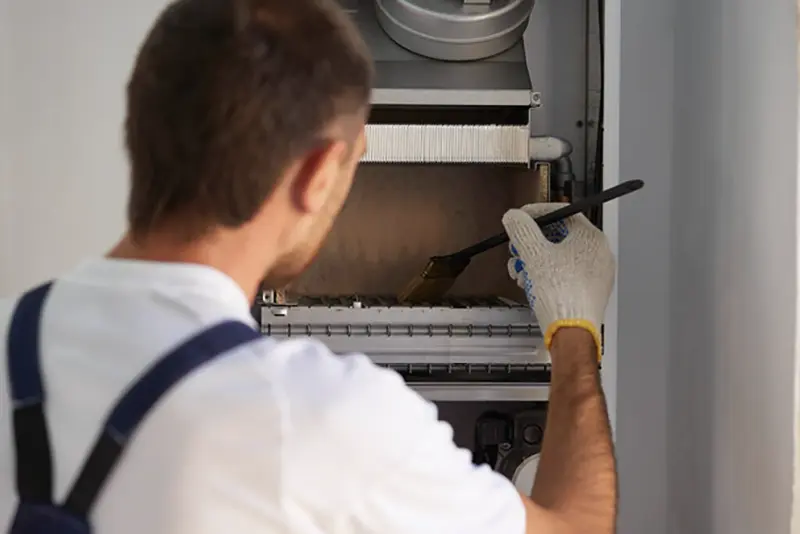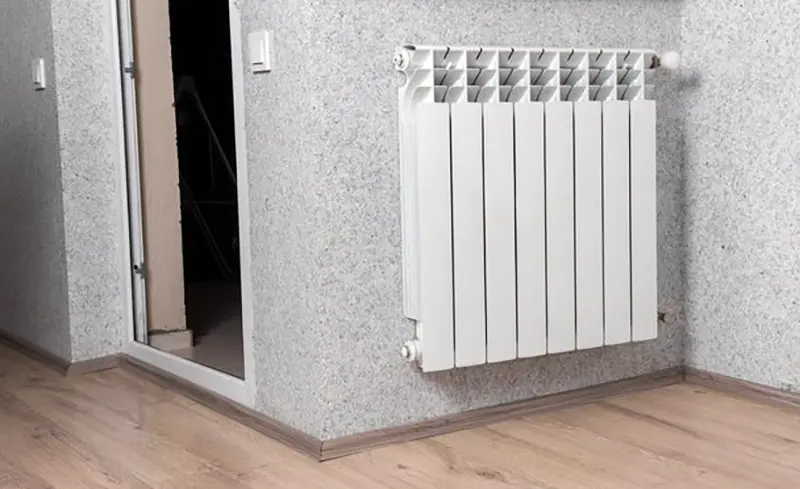Have you ever experienced a headache that won’t go away, accompanied by nausea and fatigue? You could be suffering from carbon monoxide poisoning and not even realize it. Invisible and undetectable, yet incredibly dangerous; carbon monoxide gas leaks from faulty heaters can be a real health hazard.
Learn more about the dangers of faulty gas heating systems and how to stay safe against carbon monoxide poisoning.
What is Carbon Monoxide?
Carbon monoxide is a gas that’s totally undetectable. It’s colorless, odorless, and can be deadly if it builds up in your home. Carbon monoxide is created when fuel (like gas, wood, or oil) doesn’t completely burn. This incomplete combustion releases the poisonous gas into the air. If you don’t have a carbon monoxide detector installed in your house, you could be at risk of suffering from poisoning. Symptoms can include headaches, nausea, confusion, dizziness, and even loss of consciousness.
Yikes! Make sure your home is protected with a carbon monoxide detector to avoid any nasty surprises. But that’s not the only risk of gas heaters – next we’ll look at why they can be dangerous.
Why Gas Heaters Can Be Dangerous
Gas heaters can be a real danger if they’re not maintained or used properly. Not only can they cause carbon monoxide poisoning, but gas leaks can also lead to serious health risks. Plus, if you don’t have the right safety features in place, your home could become a fire hazard. To make sure you stay safe and sound when using a gas heater, here are some tips to keep in mind:
- Make sure all your appliances are regularly serviced and checked for any faults.
- Keep an eye out for any signs of gas leaks such as an odd smell or strange noises coming from the heater.
- Install carbon monoxide detectors around your home and check their batteries regularly – you don’t want to be caught off guard!
- Don’t store any flammable materials near your gas heater and ensure that all pilot lights are extinguished before leaving the room.
- Finally, never leave a space heater unattended – it’s just not worth the risk!
So there you have it folks – if you’re gonna use a gas heater, make sure you do it safely or else you’ll be in hot water (literally).
Signs and Symptoms of Carbon Monoxide Poisoning
The most common symptom of carbon monoxide poisoning is shortness of breath – if you start having trouble breathing while near a gas heater, get out immediately! Other symptoms include nausea, headaches, dizziness and confusion. If your oxygen level drops too low, it can even lead to loss of consciousness or worse.
So never ignore these warning signs – if you think someone has been exposed to high levels of carbon dioxide, call 911 right away! And make sure your home is equipped with working carbon monoxide detectors as an extra layer of protection.
Shortness of Breath
Shortness of breath can come on suddenly so pay attention. It’s an early warning sign that something ain’t right and you might have too much carbon monoxide in your house. If you start feeling woozy or like you can’t catch your breath, it’s time to high-tail it outta there pronto! Don’t wait around – head straight for fresh air and call 911 immediately.
The earlier you act, the better your chances are of avoiding serious health issues from carbon monoxide poisoning. So keep an eye out for any potential signs and take action fast if things start looking sketchy.
Loss of Consciousness
This is one of the more serious symptoms of carbon monoxide poisoning and it ain’t no joke. You might start feeling dizzy and out of it, like you can’t stay awake or concentrate on stuff. That’s when you know it’s time to bounce ASAP!
Don’t mess around if you think something isn’t right – get outta there quick and call 911. Loss of consciousness is a sign that your oxygen levels are dropping dangerously low and could lead to some major health issues down the line. So don’t wait around – grab some fresh air as soon as possible!
Be sure to keep an eye on any potential signs of carbon monoxide poisoning, especially loss of consciousness. Don’t take chances – play it safe and act fast if things start looking sketchy.
Headaches, Dizziness and Nausea
If you’re using a gas heater and start feeling some serious headaches, dizziness or nausea – like your head is spinning or you can’t stop throwing up – it’s time to get out of there. This could be a sign of carbon monoxide poisoning and it’s nothing to play around with.
Don’t ignore the signs just because they don’t seem that bad, ’cause this poisoning can get way worse over time. So if you feel any of these symptoms, get outside into some fresh air and call 911 right away! If possible, open windows or turn off the appliance so it stops emitting fumes.
Causes of Faulty Gas Heaters

There’s more to faulty gas heaters than meets the eye. More often than not, they can be caused by a few different things.
First up, there could be an issue with the pilot light. This is what ignites the flame and keeps it burning so your heater can keep you warm when it gets chilly out. But if it’s not working correctly then your heater won’t work as intended.
Another common problem is a gas leak or incomplete combustion of natural gas, which leads to dangerous levels of carbon monoxide or carbon dioxide in the air. This means you’re breathing in toxic fumes that can make you feel dizzy, nauseous and eventually lead to loss of consciousness or even death if left unchecked.
Finally, some heaters don’t adhere to safety standards and lack basic features like automatic shut-off valves or carbon monoxide detectors that warn you when oxygen levels are too low. So always check for these safety features before you buy a new heater and make sure you get one from a reputable brand!
Faulty gas heaters can be a nightmare but following the advice above will ensure you get a safe and reliable heater that will keep your home warm and comfortable. Next up, let’s explore the dangers of incomplete combustion and why it can be so hazardous to your health!
Incomplete Combustion
Incomplete combustion is a serious problem that can not only cause your gas heater to be faulty, but it can also be a major health hazard. When natural gas isn’t combusted properly, it releases toxic gases like carbon monoxide and carbon dioxide into the air. Breathing in these fumes can lead to shortness of breath, dizziness, nausea, and even death if levels get too high! So make sure you’re checking for signs of incomplete combustion regularly.
Look out for any hissing or whistling noises coming from your heater, as this could indicate a gas leak. If you have an electric or portable space heater, look out for any flammable materials around the heater – these are a big no-no when it comes to safety!
Finally, check those pilot lights on your gas water heaters every so often – if they go out then your home could quickly fill up with dangerous gases. Don’t let yourself be caught off guard – stay safe by keeping an eye on your heating system at all times!
Pilot Lights Malfunctioning
Watch out for your pilot lights, because they can be majorly dangerous if they malfunction! If your pilot light goes out, it can cause a natural gas leak and release dangerous levels of carbon monoxide into the atmosphere. Carbon monoxide is bad news – it can lead to oxygen deprivation, loss of consciousness, and even death! So keep an eye on those pilot lights and make sure you’re checking them regularly!
If they start acting up or you hear any hissing noises coming from near your heater, switch off the gas supply ASAP and get an expert to check it out. Don’t risk your health or safety – stay safe by taking proper precautions when dealing with faulty gas heaters.
Faulty Gas Appliances
Make sure you’re always checking for gas leaks, carbon monoxide poisoning, or other faulty combustion that could be happening with your appliance. And invest in a carbon monoxide detector – even if you don’t have any gas appliances in the house, this is still one of the best ways to protect yourself from dangerous levels of carbon monoxide.
If something seems wrong or off with your heater, shut off the gas supply and contact an expert immediately. Don’t mess around – faulty gas heaters can lead to some serious health risks like shortness of breath, oxygen deprivation, and even death! Play it safe and stay on top of all your gizmos.
Safety Tips for Avoiding Carbon Monoxide Poisoning from Gas Heaters
Carbon monoxide poisoning is a real risk with these appliances, so keep an eye out for any signs of faulty combustion. Make sure you got your carbon monoxide detector up and running, because that thing’s your best protection against this silent killer. And if you ever smell something weird coming from your heater, shut off the gas supply and get an expert in ASAP.
Keep up on all the maintenance too – check in on your pilot lights every now and then, just to make sure they’re still turning. Last but not least, don’t forget about the safety features! Portable heaters often have built-in sensors that’ll shut them down if something goes wrong. Bottom line: Stay alert when it comes to gas heaters and you’ll stay safe.
At the end of the day, your gas heater can be a real safety hazard if you don’t pay attention to it. So stay safe and stay on top of things – regular maintenance and inspections are key! Oh, and one last thing: Don’t forget to regularly inspect your heater for leaks or damage – trust us, it’s worth the effort!
Regularly Inspect Your Heater for Leaks or Damage
Don’t be letting leaks or damage slide when it comes to your heater. Inspections are key if you wanna stay safe and sound. Look for telltale signs like smelling something funky coming from the machine, seeing soot around the pilot light, hearing funny noises like hissing, or feeling a chill in the air when it’s blasting. If any of these happen, shut off the gas supply and get a pro in to take a look ASAP.
Don’t forget about those safety features either – most portable heaters have built-in sensors that’ll shut them down if something goes wrong. Bottom line: Keep up with inspections and you won’t have anything to worry about!
Ensure Proper Ventilation when Using a Portable or Electric Heater
Portable heaters can get real hot and release carbon monoxide and other dangerous gases. To protect yourself, make sure you keep these heaters away from flammable materials like furniture, curtains and rugs – put them in an open space where the air can circulate properly and the heat can escape.
Same goes for electric heaters – if they’re too close to something that could catch fire, they’ll do more harm than good.
In general, try to keep at least three feet between your heater and any flammable objects. And of course, always have a carbon monoxide detector nearby so you know if something’s not right. Keep the area well ventilated and you should be good to go!
Conclusion
Bottom line – faulty gas heaters can be real dangerous if you don’t stay on top of them. Pay attention to your pilot lights and make sure there’s no funny smells, sounds or sights coming from your heater. And make sure you got yourself a carbon monoxide detector so you know when something’s not right. Don’t forget about inspections either – these are a great way to catch any potential issues early on.
And last but not least, always ensure proper ventilation when using a portable or electric heater – this will help keep your home safe and sound.





